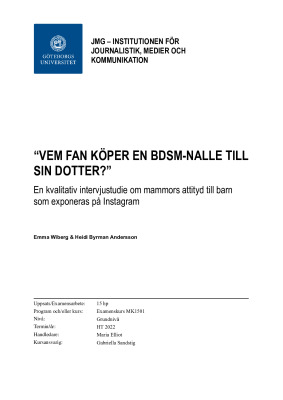“VEM FAN KÖPER EN BDSM-NALLE TILL SIN DOTTER?”
En kvalitativ intervjustudie om mammors attityd till barn
som exponeras på Instagram
Executive summary
Over the past few decades, the digital landscape has grown and become increasingly common in our everyday lives. Not least to publish, inspire and update others about our life on social media. And for some, life also includes the role of being a mother, perhaps one who is proud to show off their children on social media. Up to now, France is the only country in the world to have enacted a law to control parents who expose their children to online platforms for financial purposes, which has become a debate all over the world. But the question is – who is then responsible for what content is being published? Who decides what kind of content is morally right or wrong?
The purpose of this study is to investigate the attitude of mothers and how they respond to media content and brands that expose children in their advertisements on Instagram. As we intend to achieve an understanding of how mothers’ morals and ethics stand in relation to the phenomenon of Sharenting and consumption. To fulfill the purpose of this study, the empirical data consisted of seven respondents who required to live in Gothenburg, have at least one child under the age of 18, and are daily users of the media platform Instagram. And through
semi-structured interviews with our respondents, we have obtained the empirical data which we later analyzed. The study is also based on the following four theories; Media ethics, Parasocial relations, Sharenting and the ABC model.
In order to seek the purpose of this study, we stated three questions that guided us throughout
this whole process. The questions we aimed to reach are the following:
● How do the respondents interact with/respond to the phenomenon of Sharenting on the media platform Instagram?
● How do the respondents interact with media content where children are exposed in an advertising context on Instagram?
● What is the respondents attitude towards the brands that publish media content on Instagram where children are exposed?
Based on the results we found that mothers’ attitude, and how they relate to children who are exposed in the context of advertising on Instagram, is a twofold problem when it comes to their media ethics. There is a gray area around their attitude and how they relate to advertising contexts on Instagram. However, the respondents are generally positive about their own exposure of their child or children, hence their mother’s role was significant in their media content. Still, they show an increasingly negative attitude towards mother influencers who exposed their children on the media platform.
Respondents highlighted the risks that come with exposing children to Instagram, but that an interaction and recognition with their media content had a significant role in their attitude and how they relate to the media platform’s posts. Finally, we gained an understanding of how
media content can be an explanatory factor as to whether the respondents motivate their consumption. The result shows that Instagram stretches the morals of the respondents regarding what is right or wrong. For example, privacy online is not as ”important” as offline, as the platform through ongoing small adjustments – such as algorithms and cookies – can normalize the behavior of our respondents. In other words, it is difficult to examine children’s
participation in social media such as Instagram based on only the research field that includes communication, without taking into account both the legal, psychological and philosophical aspects that challenge the respondents’ way of thinking.

